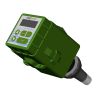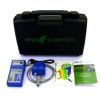Eno Scientific Well Watch 700 Water Level Monitor
Features
- Measures water levels using sound waves, no risk of contamination
- Complete well management and control, providing real time asset data
- Simple external installation, no well decommissioning (prior or during)
- Free ground shipping
- Expedited repair and warranty service
- Lifetime technical support
- More
Overview
The Eno Scientific Well Watch 700 can measure water levels in commercial water wells with levels down to 7000 ft, up to 30" diameter, and with top mount turbine or submersible pumps. Operating on low frequency sound waves, there is no need for equipment to be lowered down into the casing. The versatile sound waves can travel past obstructions, installed well equipment and around corners. The Well Watch boasts an intuitive software that monitors well conditions and automatically adjusts to maintain the most accurate readings.
Mechanics
The Eno Scientific 700 was designed to be a well management hub and provides users with static, drawdown, recovery and flow data at an interval chosen by the user. The Well Watch 700 boasts two independently programmable relays for pump control and remote alarms. There are multiple outputs to choose from including RS232, RS485, 4-20mA, 0-5V, SDI-12 and Ethernet to communicate with any pre-existing system. An internal data logger allows it to operate as a stand alone system or a backup in case of communication loss, logging up to 25 million data points. Collected data can be accessed over the USB connection or by removing the SD card.
In The News
Reimagining Water Filtration: How Monitoring and Science Enhance FloWater Filtration Systems
Over 50% of Americans think their tap water is unsafe , according to the Environmental Working Group (EWG). Other recent surveys have found that number to be as high as 70% of persons surveyed. Whether due to increased public awareness of water quality issues or confusion about how municipal water sources are regulated, there is a clear distrust of tap water in the United States. According to industry expert Rich Razgaitis, CEO and co-founder of the water purification company FloWater, this issue creates a damaging cycle. Razgaitis explained that the health and environmental problems associated with contaminated water aren’t the only issues. As people become increasingly aware that some tap water is unsafe, they resort to bottled water.
Read MoreMonitoring New Hampshire’s Aquatic Ecosystems: Continuous Data Collection in the Lamprey River Watershed
New Hampshire’s aquatic ecosystems provide a range of ecosystem services to the state and region. Resources and services like clean water, carbon storage, climate regulation, nutrient regulation, and opportunities for recreation all depend on New Hampshire’s aquatic ecosystems remaining healthy. Jody Potter, an analytical instrumentation scientist at the University of New Hampshire (UNH), is studying these aquatic ecosystems in hopes of developing an improved understanding of ecosystem services and their interactions with climate change, climate variability, and land use changes. [caption id="attachment_39799" align="alignnone" width="940"] Aquatic sensors in the Merrimack River in Bedford, NH, with I-293 in the background.
Read MoreFrom Hurricanes to Florida’s Red Tides: Monitoring the Southwest Gulf Coast
Nearly every year, southwest Florida is blighted by harmful Karenia brevis blooms–known colloquially as Florida red tides. These harmful algal blooms (HABs) form over the West Florida shelf and are pushed shorewards by winds and currents. Once in touching distance of the coast, they often intensify, fed by land-based runoff, anthropogenic nutrients, and decomposing marine life killed by toxins produced by these red tides. Red tides have become more severe and persistent over the past 20 years, causing major environmental and economic damage.
Read More










